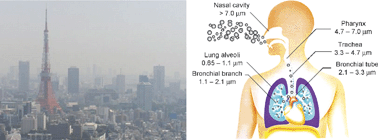Airborne particulate matter (APM) is a major air pollutant, and the effect on human health of fine APM (PM2.5) deposited deep inside the lungs has recently become a serious concern. Moreover, soluble constituents may leach from APM, and intensify some health disorders. To identify the soluble chemical constituents of APM, size-classified APM was sampled in central Tokyo, and the elemental compositions of the water-soluble, acid-soluble and insoluble fractions were investigated. The extraction procedure was validated by calculating the mass balance of soluble and insoluble fractions of a standard APM reference material (NIST SRM 1648). Among the major elements, Fe and Ti in APM of all size classes and K in coarse APM were distributed primarily in the insoluble fraction and were inferred to be present as oxides or silicates, whereas Na and Mg in all size classes and K in fine APM were primarily in the water-soluble fraction and were inferred to be have originated mainly from sea salt. Among the trace elements, Zn and Cd in the fine APM (d < 2 µm) had large enrichment factors, indicating an anthropogenic origin, and were distributed primarily in the water-soluble fraction. When fine anthropogenic APM enters into the lungs, leached toxic elements, such as Cd, may adversely affect health. The higher the bonding energy of the monoxide molecule of the element was, the higher its distribution ratio was in the water-soluble fraction. Therefore, many metallic elements in APM were inferred to be present as oxygen-bonded compounds.


 Please wait while we load your content...
Please wait while we load your content...